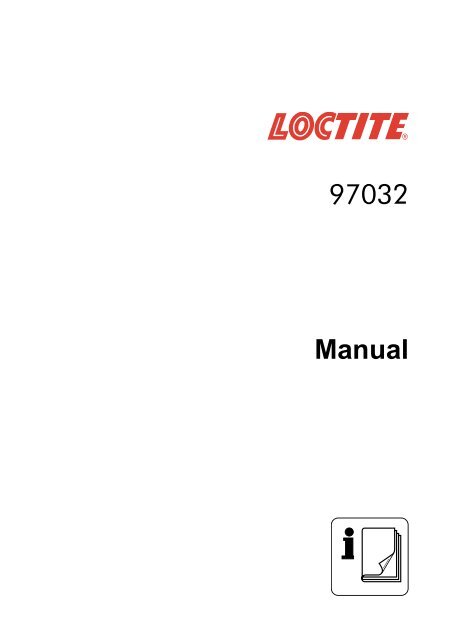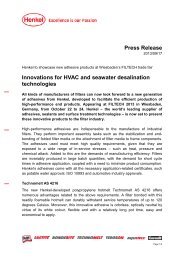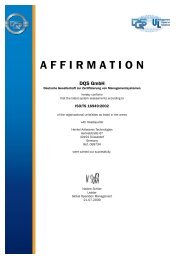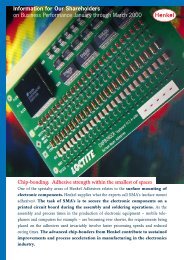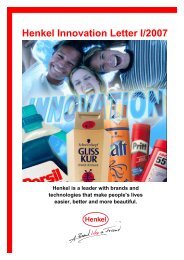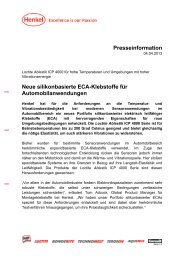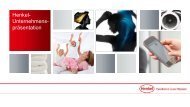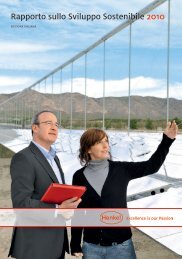97032 Manual - Henkel
97032 Manual - Henkel
97032 Manual - Henkel
Create successful ePaper yourself
Turn your PDF publications into a flip-book with our unique Google optimized e-Paper software.
<strong>97032</strong><br />
<strong>Manual</strong>
981211<br />
Before operating your Loctite <strong>97032</strong> please read this manual<br />
carefully.<br />
Contents<br />
Diagram Front Panel<br />
Rear Panel<br />
Diagram Changing the Lamp-Module<br />
Removing Transport Safety Cushions<br />
1. Prior to Operation<br />
2. Operation<br />
3. Special Instructions<br />
4. Changing the Lamp-Module<br />
5. Accessories and Spare Parts<br />
6. Information on UV Spectra<br />
7. Technical Data<br />
1
000000<br />
h<br />
FRONT PANEL<br />
REAR PANEL<br />
0 0 0 0<br />
Lightguide<br />
Socket<br />
Timer<br />
Set<br />
Timer<br />
Mains Switch<br />
Timer Start<br />
Hours<br />
Counter<br />
Fan<br />
Exhaust<br />
Mains<br />
Fuse<br />
Timer<br />
Off<br />
Footswitch<br />
Socket<br />
Mains<br />
Socket<br />
2
1<br />
Lampmodule<br />
3<br />
CHANGING THE LAMP-MODULE<br />
2<br />
2<br />
Remove: 1....2....3<br />
Insert: 3....2....1<br />
REMOVING TRANSPORT SAFETY CUSHIONS<br />
11111 11111<br />
00000 00000<br />
11111 00000<br />
00000 11111<br />
11111 11111<br />
00000 00000<br />
11111 00000<br />
00000 11111<br />
11111 11111<br />
00000 00000<br />
11111 00000<br />
00000 11111<br />
0000011111<br />
00000<br />
11111<br />
3
1. Prior to operation of the unit check the following items carefully:<br />
Transport Safety Cushions<br />
During transport lamp is protected by foam cushions. As failure to remove these will<br />
destroy the lamp, it is also electrically disconnected during transport. Follow the<br />
instructions “Changing the Lamp-Module” to remove the foam cushions.<br />
Mains Supply<br />
Make sure voltage and frequency on the nameplate match with your local mains<br />
supply. Connect power cord to a properly grounded AC outlet.<br />
UV-Lightguide<br />
Insert the flexible LIQUID LIGHTGUIDE with the Ø16mm fitting into the lightguide<br />
socket in the front panel of the lightsource. Attention: Shutter will not operate unless<br />
lightguide is fully inserted. Treat the lightguide with care, it is an optical instrument.<br />
Do not kink or crush it and do not bend it too sharply to avoid light losses. From time<br />
to time clean lightguide end faces with a soft tissue and solvent.<br />
When using a dual branch LIQUID LIGHTGUIDE the two branches must be<br />
positioned vertically above each other in the lightguide socket in the front panel.<br />
Only this position ensures maximum radiation output. Insert the lightguide all the<br />
way into the socket and rotate it until it snaps into vertical position. For technical<br />
reasons the radiated power of the two branches may differ up to a ratio of 40:60<br />
percent.<br />
Ventilation<br />
Cooling air is sucked through opening at the bottom of the unit, hot air is expelled at<br />
the back. Both openings may not be obstructed in order to allow free ventilation.<br />
Obstruction of these openings will cause unit to overheat.<br />
Vapours of Solvents<br />
Vapours of fluorinated or chlorinated hydrocarbon solvents will corrode the lamp<br />
and the quartz lenses – even in small concentrations. Avoid these solvents in the<br />
vicinity of the unit. If you cannot avoid them, place the unit as high as possible, as<br />
vapours are heavier than air.<br />
Explosive Surroundings<br />
This unit is not meant for operation in explosive surroundings.<br />
Protection against UV-Radiation<br />
To avoid tissue damage do not expose the unprotected eye or skin to the ultraviolet<br />
light. For more information on UV radiation please refer to chapter 6.<br />
4
2. Operation<br />
Warming up<br />
Turn on the mains supply through the green switch on the front panel. The lamp will<br />
ignite and the fan will begin to operate. After a warm-up time of approximately 15<br />
minutes the lamp reaches its full power. Switching off during warm-up can damage<br />
the lamp. Every ignition wears the lamp, similar to the cold start of a car engine, we<br />
therefore recommend not to switch off the unit if you need it again within the next<br />
three hours.<br />
Shutter and Timer<br />
After pressing the orange starter button the shutter will open for the selected amount<br />
of time (selectable from 0.1 to 999.9 seconds) and release the UV radiation; holding<br />
the starter button will extend exposure time. If the timer is set to “000.0”, the shutter<br />
will open only as long as the orange starter button is pressed; alternatively the timer<br />
can be switched off on the rear panel. The footswitch which can be connected to the<br />
rear panel has the same function as the orange starter button. For integration into<br />
external control systems the footswitch can be replaced by a galvanically isolated<br />
closing contact.<br />
Switching off<br />
The green switch on the front panel will turn off the lamp and the mains supply.<br />
Reignition<br />
If the unit is switched off, allow the lamp to cool down for at least 10 minutes prior to<br />
reignition. Do not attempt reignition earlier as this may damage the lamp.<br />
3. Special Instructions<br />
Lamp Life<br />
Based on operating intervals of a normal working day UV radiation power of the<br />
lamp will drop to approximately 50% after 600 operating hours, and the lampmodule<br />
should then be replaced.<br />
Repairs and Service<br />
Always disconnect power cord before opening up the unit. Do not attempt any<br />
repairs other than exchanging the lamp-module (see instructions “Changing the<br />
Lamp-Module”). Refer all other repairs to an authorized service facility.<br />
5
4. Changing the Lamp-Module<br />
The changing of the lamp-module should be done only after the lamp has<br />
completely cooled off. Please proceed as follows (see diagram):<br />
• Disconnect the power cord.<br />
• Remove the top cover of the unit by unscrewing the two upper screws on the<br />
left and right hand side of the unit respectively, disconnect earth wire. Remove<br />
the knurled screw on the side of the lamp-module.<br />
• Unplug the lamp-module connectors and remove the module carefully by a<br />
simultaneous backwards and upwards movement.<br />
• Remove the transport safety cushions from the new lamp-module and insert it<br />
by vice-versa procedure.<br />
• Plug in the connectors of the lamp-module and the earth wire of the top cover<br />
and close the cover.<br />
5. Accessories and Spare Parts<br />
Power cord<br />
Footswitch with cable and connector<br />
LIQUID LIGHTGUIDE: single branch type active Ø5mm x length 1500mm<br />
(type optional)<br />
single branch type active Ø8mm x length 1500mm<br />
Pre-aligned snap-in lamp module, new<br />
dual branch type 2 x active Ø3mm x length 1500mm<br />
Other lengths and adaptors available on request.<br />
6
6. Information on UV Spectra<br />
and the different filter options of the Loctite <strong>97032</strong><br />
The ultraviolet spectrum is divided into three sections:<br />
UVA 315nm – 380nm<br />
UVB 280nm – 315nm<br />
UVC 100nm – 280nm<br />
UVA is a part of natural sunlight and it’s most visible effect on human tissue is the<br />
tan. It’s intensity is easily underestimated, as it is not visible. An overdose of UVA<br />
will not cause a UV-erythema (sunburn) but a heat-erythema similar to visible light.<br />
UVB is more aggressive than UVA, and also a part of natural sunlight. It has the<br />
same negative effects on human tissue as natural sunlight, the most common being<br />
the UV-erythema (sunburn).<br />
UVC is not generated by the lamp in this unit and not transmitted by the LIQUID<br />
LIGHTGUIDE.<br />
For safety reasons it should generally be avoided to expose the unprotected eye or<br />
skin to the ultraviolet light.<br />
For a maximum of operational safety this unit is generally equipped with<br />
“UVA + blue” filters which are integrated into the unit. The blue light serves as<br />
pilot light.<br />
UV epoxies mostly have their maximum efficiency in the UVA. However most<br />
epoxies also react to UVB, which means that they cure faster when they are<br />
exposed to UVA and UVB. Some epoxies will not cure without UVB and UVB is also<br />
helpful in reducing surface stickiness. So from a technical and economical<br />
standpoint the “UVA + blue” filter holds back UV energy which can be very useful.<br />
On special request this unit is equipped with either “UVB + UVA + blue” filters or<br />
with “UVB + UVA + visible” spectrum, the latter meaning it has no filters at all for<br />
maximum efficiency. When working with UVB extra precautions must be taken and<br />
operating personnel must be completely shielded from the UV radiation.<br />
Please check the serial number and radiation spectrum in chapter 7 of this manual<br />
to see with which filters your unit has been equipped.<br />
Competitive units may have a different spectral output. A comparison of radiation<br />
power of different units is only possible if they emit the same spectrum.<br />
7
7. Technical Data<br />
Model: Loctite <strong>97032</strong> Serial Number: __________________<br />
Voltage: 230/240 Volts 50/60Hz (see nameplate)<br />
Current: 3.2 Amps<br />
Fuse: 6.3 Amps, slow blow<br />
Lamp type: 200 Watt superpressure mercury arc AC lamp<br />
Lamp life: approx. 600 hours<br />
Remote control terminal (footswitch): 24VDC, 50mA<br />
Dimensions: 265mm wide, 150mm high, 255mm deep<br />
Weight: 7.5 kg<br />
Radiation spectrum (built-in option is marked “X”):<br />
O 320nm – 500nm UVA + blue (standard option)<br />
O 280nm – 500nm UVB + UVA + blue<br />
O 280nm – 700nm UVB + UVA + visible (no filters)<br />
Data on UV radiation power is deliberately not given as common standards of<br />
measurement do not exist and measuring instruments of different manufacturers<br />
deliver data which are not comparable. However, you are invited to compare –<br />
using the same measuring instrument.<br />
This product conforms to the Council Directive 89/336/EEC<br />
(Electromagnetic Compatibility, EMC) and to the Council Directive<br />
73/23/EEC (Low Voltage Directive).<br />
8


